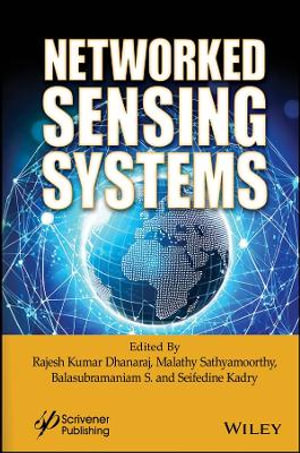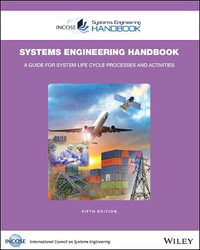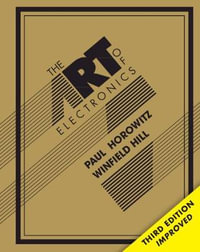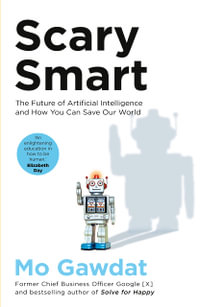
Networked Sensing Systems
By: Rajesh Kumar Dhanaraj (Editor), Malathy Sathyamoorthy (Editor), Balasubramaniam S. (Editor), Seifedine Kadry (Editor)
Hardcover | 7 February 2025 | Edition Number 1
At a Glance
416 Pages
Hardcover
$478.95
or 4 interest-free payments of $119.74 with
orAims to ship in 15 to 25 business days
When will this arrive by?
Enter delivery postcode to estimate
Networked Sensing Systems is essential for anyone seeking innovative and sustainable solutions across diverse sectors. It explores the integration of cutting-edge IoT technologies and digital transformation aimed at enhancing resource efficiency and addressing climate change challenges.
With today?s advancements in wireless and mobile connectivity, Internet of Things (IoT) sensor technologies, and digital innovation, sustainability principles are increasingly reinforcing one another. To transition to more resource-efficient solutions, use resources responsibly, and streamline operations, businesses must embrace digital transformation. Potential application areas include energy management, air pollution monitoring, fleet management, water management, and agriculture. Simultaneously, the expansion of IoT deployments and their integration into the contexts of 5G and emerging 6G mobile networking necessitate that the solutions themselves be green and sustainable. This includes incorporating energy- and environmentally-conscious technical solutions for communications.
By offering previously unattainable solutions, networked sensing can contribute to a more sustainable society by enabling the collection of data from heterogeneous sources in unique and novel ways. Additionally, the networking-based solutions themselves must be sustainable and environmentally friendly. For example, optimizing network architecture and relocating network equipment to strategic locations can significantly reduce energy waste. These goals drive the search for improved sensing technologies, emphasizing energy-efficient mobile sensing devices.
The goal of Networked Sensing Systems is to present and highlight the latest developments in sustainable networked sensing systems across a variety of contexts, all united by the aim of enhancing human well-being and combating climate change. Regardless of the area of expertise, this work seeks to offer practical solutions to the major challenges of building a sustainable smart society 5.0. This book serves as a platform to discuss networked sensing systems for a sustainable society, focusing on systems and applications based on mobile computing and wireless networks, while adopting multidisciplinary approaches that emphasize the human element in addressing these challenges.
Preface xvii
1 Introduction to Network Sensing Systems in Society 5.0: Issues and Challenges 1
Ankit Kumar, Anurag Kumar Kanojiya and Subitha D.
1.1 What is Society 5.0? 2
1.2 Network Sensing Systems in Society 5.0 5
1.3 Issues and Challenges 6
1.4 Encryption and Decryption Techniques: Safeguarding Data Integrity 8
1.5 Understanding Interoperability on Society 5.0 10
1.6 Importance of Robust Communication and Power Plans 12
1.7 Environmental Effects and Energy Efficiency 17
1.8 Utilizing Renewable Energy Sources 22
1.9 Conclusion 24
References 26
2 Remote and Urban Environmental Area Sensing, Connectivity Issues, and Solutions Based on Emerging Technologies 31
Abinaya M., Vadivu G., Balasubramaniam S and Sundaravadivazhagan B.
2.1 Introduction 32
2.2 Connectivity Challenges in Urban Remote Sensing 33
2.3 Artificial Intelligence for Enhancing Data Processing and Analysis 35
2.4 Case Study 37
2.5 Frameworks for Integrating Multiple Data Sources 45
2.6 The Possible Effects of Next-Generation Connectivity and 5G 52
2.7 Conclusion 57
References 58
3 Efficient Network and Communication Technologies for Smart and Sustainable Society 5.0 63
P. Kanaga Priya, R. Sivaranjani, Malathy Sathyamoorthy and Rajesh Kumar Dhanaraj
3.1 Introduction 64
3.2 Literature Survey 73
3.3 Internet of Things for Smart Connectivity 76
3.4 Next-Generation Cutting Edge Communication Technologies: 5G and Beyond 80
3.5 Edge Computing: Decentralized Processing for Low Latency 83
3.6 Blockchain Technology: Securing Data Integrity and Trust 87
3.7 Artificial Intelligence in Network Optimization 90
3.8 Energy-Efficient Networking for Sustainability in Society 5.0 92
3.9 Challenges and Opportunities in Implementing Efficient Network Technologies 95
3.10 Future Directions and Recommendations 96
3.11 Conclusion 98
References 99
4 Advanced Techniques for Human-Centric Sensing in Environmental Monitoring 101
S. Aathilakshmi, Visali C., T. Manikandan and Seifedine Kadry
4.1 Introduction 102
4.2 A Basic Human-Centric Sensing Mechanism 106
4.3 Types of Advanced HCS Environmental Monitoring System 110
4.4 Applications in Environmental Monitoring 113
4.5 Conclusion and Future Prospects 117
References 118
5 Energy-Aware System for Dynamic Workflow Scheduling in Cloud Data Centers: A Genetic Algorithm with DQN Approach 121
Hariharan B., Anupama C.G., Ratna Kumari Neerukonda and Rajesh Kumar Dhanaraj
5.1 Introduction 122
5.2 Related Works 124
5.3 Dynamic Workflow Scheduling System 127
5.4 Problem Formulation and Proposed System Architecture 133
5.5 Simulation Set-Up and Experimental Results 136
5.6 Conclusion 142
References 142
6 Efficient Load Balancing and Resource Allocation in Networked Sensing Systems—An Algorithmic Study 145
Lalitha Krishnasamy, Divya Vetriveeran, Rakoth Kandan Sambandam and Jenefa J.
6.1 Introduction to the Networked Sensing Systems 146
6.2 Understanding the Load Balancing Challenges 147
6.3 Importance of Efficient Resource Allocation 150
6.4 Overview of Existing Approaches 151
6.5 Artificial Intelligence for Resource Handing 155
6.6 Real-World Applications 163
6.7 Performance Metrics 165
6.8 Research Directions 166
6.9 Conclusion and Future Work 169
Acknowledgments 169
References 170
7 Sustainable Cities and Communities: Role of Network Sensing System in Action 173
Hitesh Mohapatra, Soumya Ranjan Mishra, Amiya Kumar Rath and Manjur Kolhar
7.1 Introduction 174
7.2 Literature Review 177
7.3 Proposed Study 181
7.4 Performance Analysis 185
7.5 Mapping of Topology with Smart City’s Applications 189
7.6 Conclusion 195
References 196
8 Air Pollution Monitoring and Control Via Network Sensing Systems in Smart Cities 199
S. Sharmila Devi
8.1 Introduction 199
8.2 Related Works 201
8.3 Air Quality System 203
8.4 Air Quality Monitoring Techniques 204
8.5 Conventional Air Pollution Monitoring 205
8.6 Wireless Sensor Network for Air Monitoring 209
8.7 Architecture of Wireless Sensor Networks 212
8.8 WSN-Based Air Pollution Monitoring in Smart Cities 216
8.9 Conclusion 221
References 221
9 Interconnected Healthcare 5.0 Ecosystems: Enhancing Patient Care Using Sensor Networks 225
Ashwini A., Kavitha V. and Balasubramaniam S
9.1 Introduction to Healthcare 5.0 226
9.2 Real-Time Monitoring Using Sensor Networks 229
9.3 Advancements in Remote Patient Monitoring 231
9.4 Early Disease Detection Through Sensor Networks 235
9.5 Leveraging Multisensor Data for Comprehensive Health Insights 237
9.6 Security Measures for Protected Health Information 240
9.7 Overcoming Infrastructure and Connectivity Barriers 241
9.8 Improving Treatment Plans Through Sensor-Generated Insights 242
9.9 Conclusion 243
References 244
10 Farming 4.0: Cultivating the Future with Internet of Things Empowered on Smart Agriculture Solutions 247
Ashwini A., S.R. Sriram, J. Manoj Prabhakar and Seifedine Kadry
10.1 Introduction to Smart Agriculture and IoT Integration 248
10.2 IoT Sensor Networks in Farming 250
10.3 Smart Pest and Disease Control in Crop Production 253
10.4 Automation and Robotics in Agriculture 257
10.5 Cloud Computing for Agricultural Data Management 262
10.6 Big Data Analytics for Predictive Farming 264
10.7 Sustainable Practices with IoT in Agriculture 266
10.8 The Future Landscape of Farming 4.0 267
10.9 Conclusion 268
References 268
11 Public Safety Management in Smart Society 5.0: A Blockchain-Based Approach 273
P.N. Senthil Prakash, S. Karthic and M. Saravanan
11.1 Introduction 274
11.2 Security Challenges in Society 5.0 278
11.3 Blockchain in Society 5.0 279
11.4 Conclusion 289
References 290
12 Virtualization of Smart Society 5.0 Using Artificial Intelligence and Virtual Reality 297
Sakthivel Sankaran, M. Arun and R. Kottaimalai
12.1 Introduction to Smart Society 5.0 298
12.2 Foundations of Virtual Reality 301
12.3 Artificial Intelligence in Smart Societies 304
12.4 Integration of AI and VR 311
12.5 AI and VR in Education 314
12.6 Smart Society 5.0 Healthcare Innovations 315
12.7 Challenges and Future Directions 316
12.8 Conclusion 318
References 319
13 Battery Power Management Schemes Integrated with Industrial IoT for Sustainable Industry Development 323
D. Karthikeyan, A. Geetha, K. Deepa and Malathy Sathyamoorthy
13.1 Introduction 324
13.2 Current Battery Technologies 325
13.3 Battery Energy Storage and Management 328
13.4 IoT and Cloud Computing Technology in BMS 334
13.5 Sustainable Developments via BMS 337
13.6 Conclusion 348
References 349
14 Trends, Advances, and Applications of Network Sensing Systems 351
Ashwini A., Shamini G.I. and Balasubramaniam S
14.1 Introduction to Network Sensing Systems 352
14.2 Real-Time Trends in Sensor Technology 355
14.3 Advancements in Data Analytics 357
14.4 Applications in Healthcare 361
14.5 Natural Disaster Detection with Response 363
14.6 Agricultural Sensing Systems 365
14.7 Intelligent Transportation Systems 367
14.8 Smart City Applications 368
14.9 Challenges 369
14.10 Conclusion 370
References 370
About the Editors 375
Index 377
ISBN: 9781394310869
ISBN-10: 1394310862
Published: 7th February 2025
Format: Hardcover
Language: English
Number of Pages: 416
Audience: Professional and Scholarly
Publisher: John Wiley & Sons Inc (US)
Country of Publication: GB
Edition Number: 1
Shipping
| Standard Shipping | Express Shipping | |
|---|---|---|
| Metro postcodes: | $9.99 | $14.95 |
| Regional postcodes: | $9.99 | $14.95 |
| Rural postcodes: | $9.99 | $14.95 |
How to return your order
At Booktopia, we offer hassle-free returns in accordance with our returns policy. If you wish to return an item, please get in touch with Booktopia Customer Care.
Additional postage charges may be applicable.
Defective items
If there is a problem with any of the items received for your order then the Booktopia Customer Care team is ready to assist you.
For more info please visit our Help Centre.
You Can Find This Book In

INCOSE Systems Engineering Handbook
5th Edition - A Guide for System Life Cycle Processes and Activities
Paperback
RRP $149.95
$92.50
OFF






















